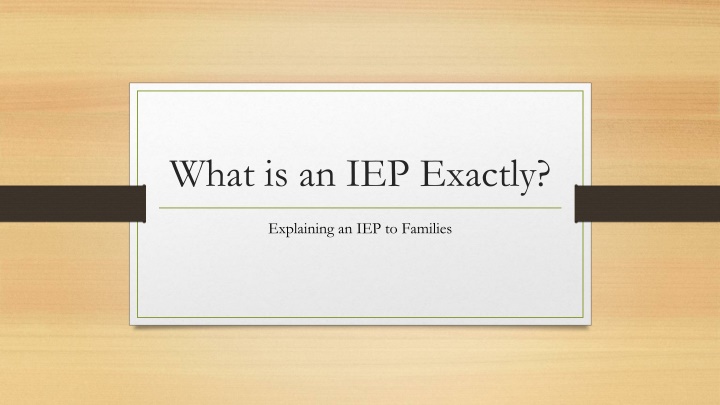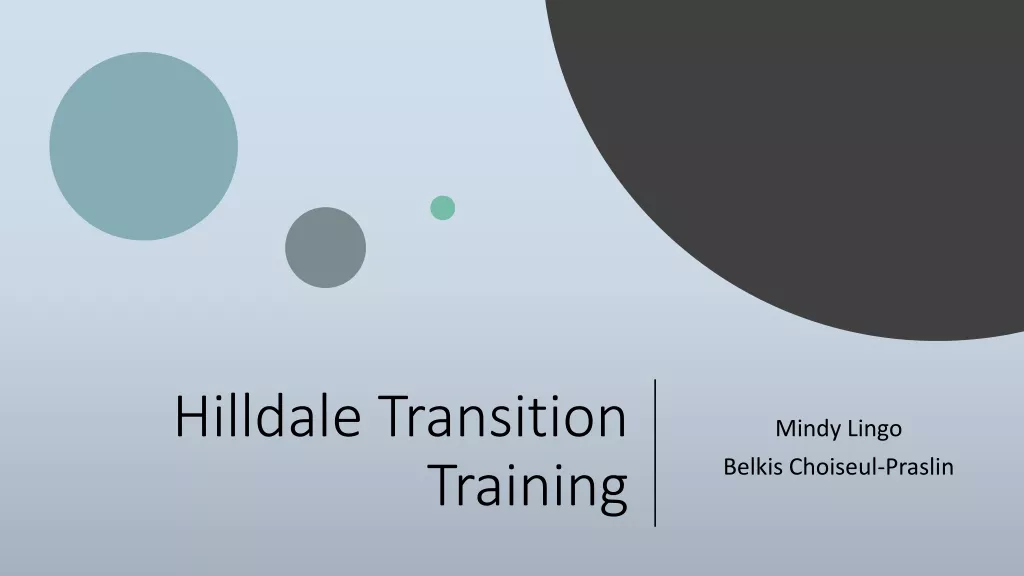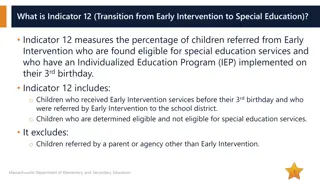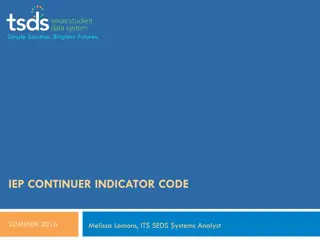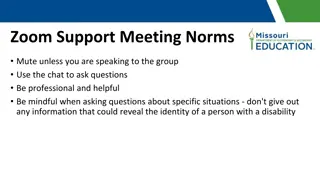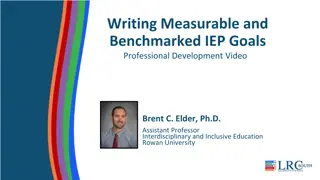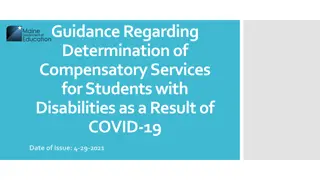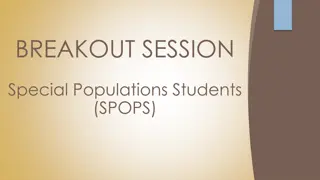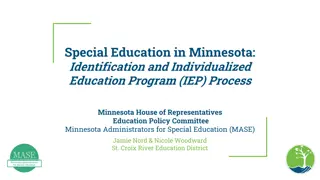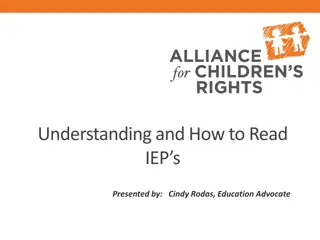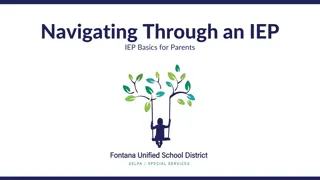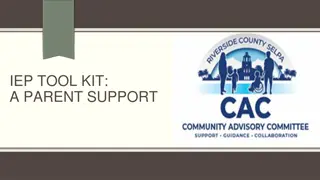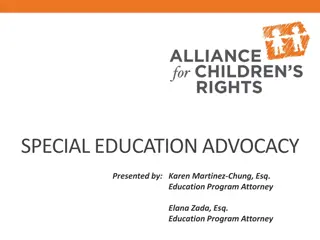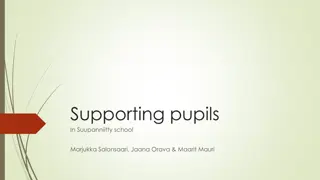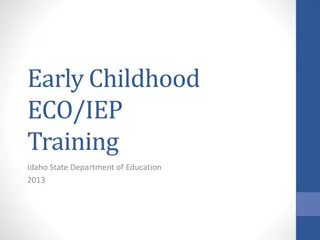Individualized Education Plans (IEP) for Student Support
Individualized Education Plans (IEP) are tailored documents developed for students with special needs, providing a roadmap for educational support. The process involves assessments by a team including parents, teachers, and administrators. Parents can request an assessment for special education services. IEP is legally binding and requires regular updates to ensure the student's needs are met effectively.
Download Presentation

Please find below an Image/Link to download the presentation.
The content on the website is provided AS IS for your information and personal use only. It may not be sold, licensed, or shared on other websites without obtaining consent from the author.If you encounter any issues during the download, it is possible that the publisher has removed the file from their server.
You are allowed to download the files provided on this website for personal or commercial use, subject to the condition that they are used lawfully. All files are the property of their respective owners.
The content on the website is provided AS IS for your information and personal use only. It may not be sold, licensed, or shared on other websites without obtaining consent from the author.
E N D
Presentation Transcript
What is an IEP Exactly? Explaining an IEP to Families
SST (Student Study Team) When a student is struggling, the parent or school will have a meeting to discuss what they can provide in order to support the student During this meeting, the team can decide to assess a student for special education services based upon the recommendations of the team. An Assessment Plan will be developed, and once consented to by the parent, the team will have 60 calendar days to complete
Parent Request for Assessment Parents have the ability to request an assessment for special education at any point Please provide district in writing the request for assessment including child s full name, school of residence and date District has 10 days to respond to the request Please list specific concerns related to the request
IEP- Individualized Education Plan An IEP is a legally binding document that an IEP team agrees to. It is derived from assessments from an educational team of diverse individuals. An IEP team can include: Parent (required participant) Student Special Education Teacher General Education Teacher Administrator/LEA Representative (required participant) Related Service Participant (SLP, OT, PT, APE, VS etc.)
IEP- Individualized Education Plan cont. The IEP supports students and staff members articulate a plan of action in order to support students with a disability. The IEP is written specifically for your child A new annual IEP is required by law to updated at least once every 12 months A triennial IEP (IEP requiring the school district or COE, to assess a student in order to determine if student is still eligible for special education services The IEP team can meet at any point if either the parent or the school team initiate and IEP team meeting (addendum/amendment)
IEP- Individualized Education Plan cont. The IEP represents a shared opinion of the IEP team in order to create a document that outlines the educational plan for the student who is eligible for special education services At the conclusion of an IEP, you as the parent can either agree to consent of the plan or sign with the exception of which outlines what you as the parent are disagreement with
Before an IEP Ask for a draft copy of the IEP document and any assessment reports that may be presented Talk with the case manager/psychologist to discuss any concerns that you may have prior to the IEP. This may help in facilitating a smooth meeting Make notes or write down questions that you may want to discuss Read all materials and sign and return the Notice of Meeting (NOM) With the NOM, indicate any additional IEP team members that you would like to invite or if you intend to audio record the meeting
During the IEP Bring a paper and pen to take notes Bring a copy of the previous 3 IEP s Share your notes and concerns that you may have written Ask questions when you do not understand something (especially important when the psychologist is presenting information) Ask that any disagreement or request be documented in the IEP notes Voice opinions in a constructive manner (everyone is discussing what they feel is best for your child) Be sure to get a finalized IEP including the signature page
Notice of Parent Rights The Parent Rights outline what the rights are for you as the parent Anytime that you meet as an IEP team or get a written response from the district or COE concerning the IEP, a copy should be offered as well The Parent Rights should be provided in your native language They should be offered prior to the start of an IEP .not after If an explanation is needed regarding your rights as the parent, please ask as this information can be overwhelming at times
Demographics and Eligibility Demographics Eligibility Outlines personal information for the student Includes parent contact information and residential information Also includes native language and EL status All students in special education could be eligible under 13 different areas: SLD, SLI, ED, AUT, MD, Deaf, VI, VI/Deaf, ID, OI, OHI, HI, TBI Student s could be found to eligible under 2 different areas (primary, secondary) Typically IEP teams choose eligibilities based upon what the students most pressing needs are REMEMBER: The students disability does not drive the services, the students needs do
Demographics and Eligibility cont. This page will also include student strengths and parent concerns relevant to the education process. The concerns need to be documented at the IEP meeting (in the notes and the section of the IEP) Documentation of what areas of need will be addressed through the IEP goals
Present Levels of Performance (PLOP) The PLOP is the current working ability of the student in multiple areas including academics, social/emotional, communication, motor skills, vocational, and health Information should be based upon actual data and needs to be relevant to the student. If it is a triennial IEP, PLOP should include more than just assessment testing results Information should be correlated to previous IEP goals and IEP goals that will be proposed during the IEP meeting
IEP Goals IEP goals are items that will be specifically targeted in order to measure a students growth Goals should be specific Goals should be measurable Goals should be achievable Goals should be results oriented Goals should be time bound
IEP Goals cont. IEP goals should be SMART!!!!!! Even though there may be 4 academic goals, it does not mean that other areas will not be covered If you are not in full agreement with the goal, I recommend to move forward with the IEP, and document your concerns, and continue to work with the IEP team to work on changing the goals
Statewide Assessments All students that are enrolled in a public school (even if they are at COE or NPS program) are required to participate in state testing Accommodations/modifications will be listed here for CELDT, PE, DRDP and State Testing Support can be embedded or non-embedded Parents have the right to opt out of testing if they inform the administrator of the school in a timely manner. All state testing is now done through the computer
Instructional Accommodations and Modifications Accommodations and modifications support student access content, instruction and other relevant facets of a school day Accommodations/Modifications might be needed to measure academic achievement and functional performance Accommodations provide support for a student to gain access to items listed above Modifications change the content in order for the student to be able to access
Services These are required direct services that need to be provided based upon the needs of a student Services can only be added or removed through an assessment Duration can increase or decrease based upon needs of the student
Migrant Education Factors to Consider
IEP Document IEP s are federal documents that can transfer from state to state; if you are eligible in one district, you are eligible in all districts IEP s will look different depending on the region you are in Some states will have different eligibilities or service trends than others (ex. New York and Arizona) When moving to a new district, district will need to complete an interim placement District will need to complete a 30 Day Review to adjust services
Communication Please work with the districts regarding communication between each other and yourself since these are shared students Before moving to your new residence, please inform the district that your child will be coming back shortly so that they can prepare for the placement/services for the student Districts should be in contact with one another to get updated regarding progress and educational programming that is beneficial for the student
